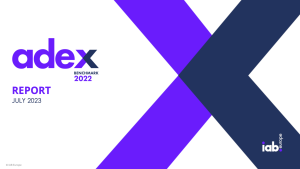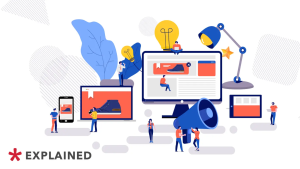On July 9, the webinar “Data-driven strategy 2020: how brands prepare for life without cookies” was held at the Admixer Academy. The main topic of the webinar was the change in the identification of Internet users industry will face in the following years.
Ban of 3rd party identifiers will affect all advertising processes, including campaign planning, targeting, audience use, attribution, and the effectiveness of evaluation.
Representatives of Adtech companies, advertising agencies, and international brands talked about how companies can prepare for the post-cookie stage before all identifiers are activated.
Data-driven strategy: How advertisers work with data
Ivan Fyodorov, Admixer New Business Director
Today each element of the ad is connected by a 3rd party ID. For the web, it is 3rd-party cookies, and for mobile applications: Apple – IDFA, Android – AAID.
If we disable these identifiers, most of the tools that place ads online will lose their functionality.
On January 14, we learned that by 2022 Google Chrome will no longer have 3rd-party cookies. Other web browsers, Firefox and Safari, banned it about a year ago. Nevertheless, Chrome’s decision to cancel 3rd party cookies stirred up the market since it is a primary world browser (up to 65% of the world population).
The role of 3rd-party ID in the advertising ecosystem:
• Planning (includes band/frequency)
• Audience targeting (according to 3rd-party data)
• Cross-device (access to the audience from different devices)
• Targeting and attribution
Cookie Removal Consequences
Will be disabled:
• Targeting 3rd-party audiences
• Verification of 3rd-party audiences
• Cross-site volume and frequency tracking
• Post-view attribute (only last-click attribute will remain)
• Remarketing strategies
• Support service (recommendations, antifraud, analytics)
Will not be disabled:
• 1st-party audience targeting
• Direct deals and placements with audience gatherings
• 1st-party analytics
• Contextual targeting
• Internal application identification system
• Panel Studies
Things that can compensate for 3d-party cookies:
For Chrome users
Browser APIs (Turtledove)
It contains information about what people engage the most. Advertisers display ads to users based on their interests but will no longer access additional information in the future. Among them, they do not know who uses the browser, which websites people visit, etc.
For Apple’s mobile app ecosystems
SKAdNetwork API
It allows the Advertiser to transfer tracking data from Apple’s ecosystem and change the direct accession or analysis of that data.
For publishers
Singe Sign-on
Technology that allows users to access multiple resources without re-authentication.
Those tools are in a testing phase, so it’s difficult to predict the final results just now.
How will the advertising methodology transform:
When the above tools start working, there will be significant changes in customer tracking and analytics:
• Can not track and send personalized messages after canceling 3rd-party cookies. So the ability to monitor specific users is lost. It will cause the need for one-on-one communication with the customers.
• The need for decision automation will increase
There will be even more segmentation of communication channels – with each user identifying their system and modified audience targeting.
• New KPIs
New approaches to advertising placement planning and evaluation, tracking tools, so econometric models will emerge.
Data-driven strategy implementation solutions:
• CRM / DMP / CDP
Systems that store customer data and provide connections between online audiences through various channels. In the future, this will allow us to track user and base segmentation.
• User Graph
The main task of this solution is to prepare a single record of various identifiers of the users, which serves to establish a connection between the identifiers on different resources.
• Data Lakes
Brands and publishers can upload their information in a personal vault. In the vault, their segments get analyzed, and brands can activate the audience by targeting. The procedure is secure and under the rules of privacy.
How to make a diet without DMP and cakes?
Alexandra Buligina, Director in Amnet Ukraine, Proud Member of Amplifi Ukraine, Dentsu Aegis Network Ukraine
Advisors must effectively manage their data to maintain competitiveness, for which DMP is the ideal solution.
To be prepared for baning 3rd-party identifiers, it is essential to use DMP and collect audience data.
It covers:
• Creating a model of user behavior by URL data, frequency of site visits, date and time of activity, as well as their actions (display, view, click);
• Track activities through 3rd-party data and understand the customer journey – what they do before entering the site.
• Test new tracking and attribution models in 3rd-party data mode to optimize your audience in the post-cookie era.
• Data Enrichment – Partnering with suppliers to increase the audience and add identifiers. Such communication can develop User Graphs in the future.
Important details:
• 1st-party data
Brands and advertisers should focus on 1st-party data collection, storage, and activation. They need to know how consumers interact with company resources (websites, apps, points of sale).
• Analytics and machine learning
Gathering analytics and algorithms for different channels, assembling effective placement models – allows insights into the action of the entire audience.
• Creativity and automation
It will be much more difficult to move customers and set up ads manually. Automate testing and the placement of creatives for different contexts is necessary.
While 3rd-party identifiers are still available, advertisers should use every opportunity to search audiences by identifying contextual targeting of users, channels, and their intersection.
How to prepare and create your ecosystem
Katerina Levchenko Danon Nutrition Marketing Director
Banning 3rd-party identifiers enhances the importance of brand digital ecosystems.
Before a potential customer starts choosing a product, he or she goes through several stages – reading expert reviews, seeking comments, and so on. At these touchpoints, the brand can already communicate with this person.
Creating your media ecosystem gives you a chance to get early contact with customers by 1st-party cookies, and leads.
By placing interesting and well-prepared content in the right place, brands can gather information about potential customers before the conversion.
When you have such resources, you can use them separately for generating leads as well as enriching your DMP.
What do you need to do to build a digital ecosystem?
• Consumer research
Identify customer skills, typical behavior, and content consumption propensity. Analyze and enrich audiences through DMP.
• Creating a Consumer Journey Roadmap
Find crossing points to discover targeted likenesses and make content types based on it.
• Finding investment resources
Determine how high the competition is between similar resources. The content project should have a clearly defined purpose – to collect cookies or leads.
Cons:
Creating complete content is a time-consuming process and can take up to 1 to 1.5 years to complete.
It also requires start-up investment and support.














